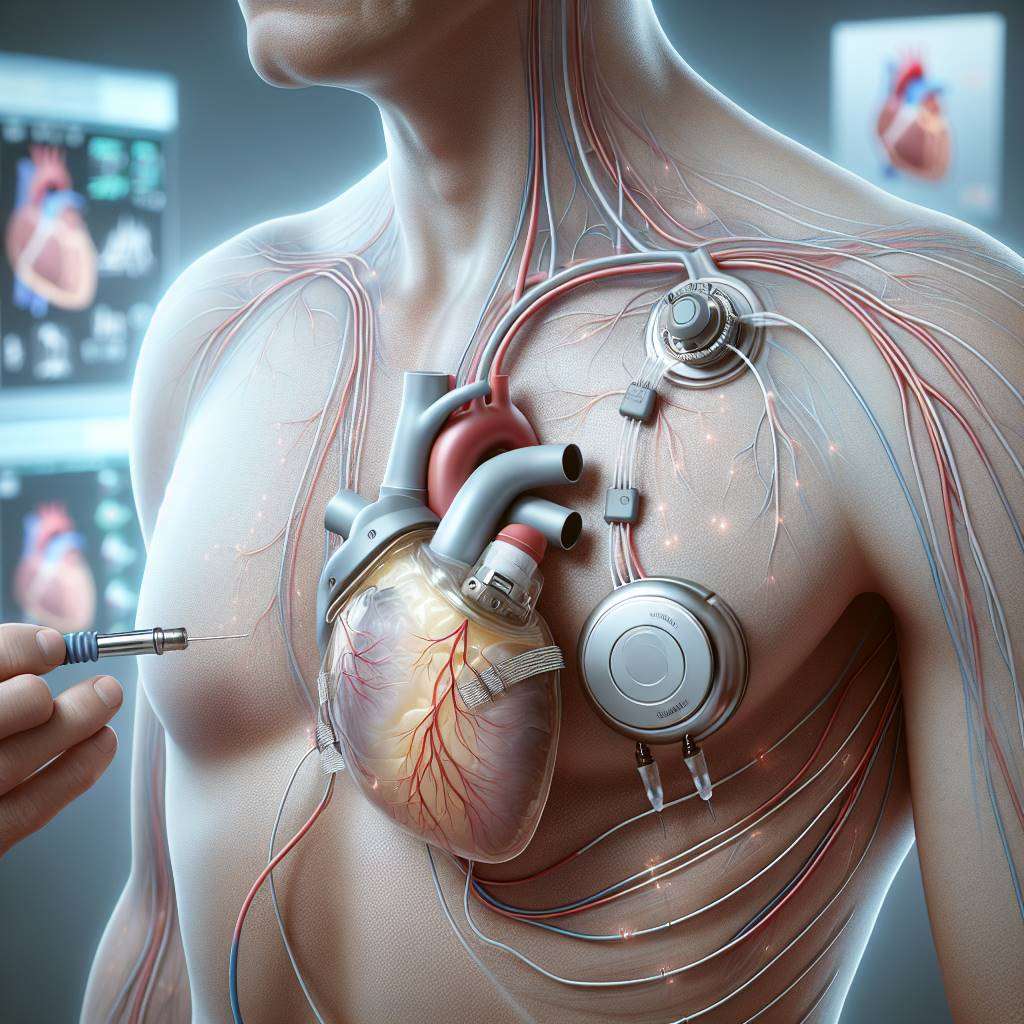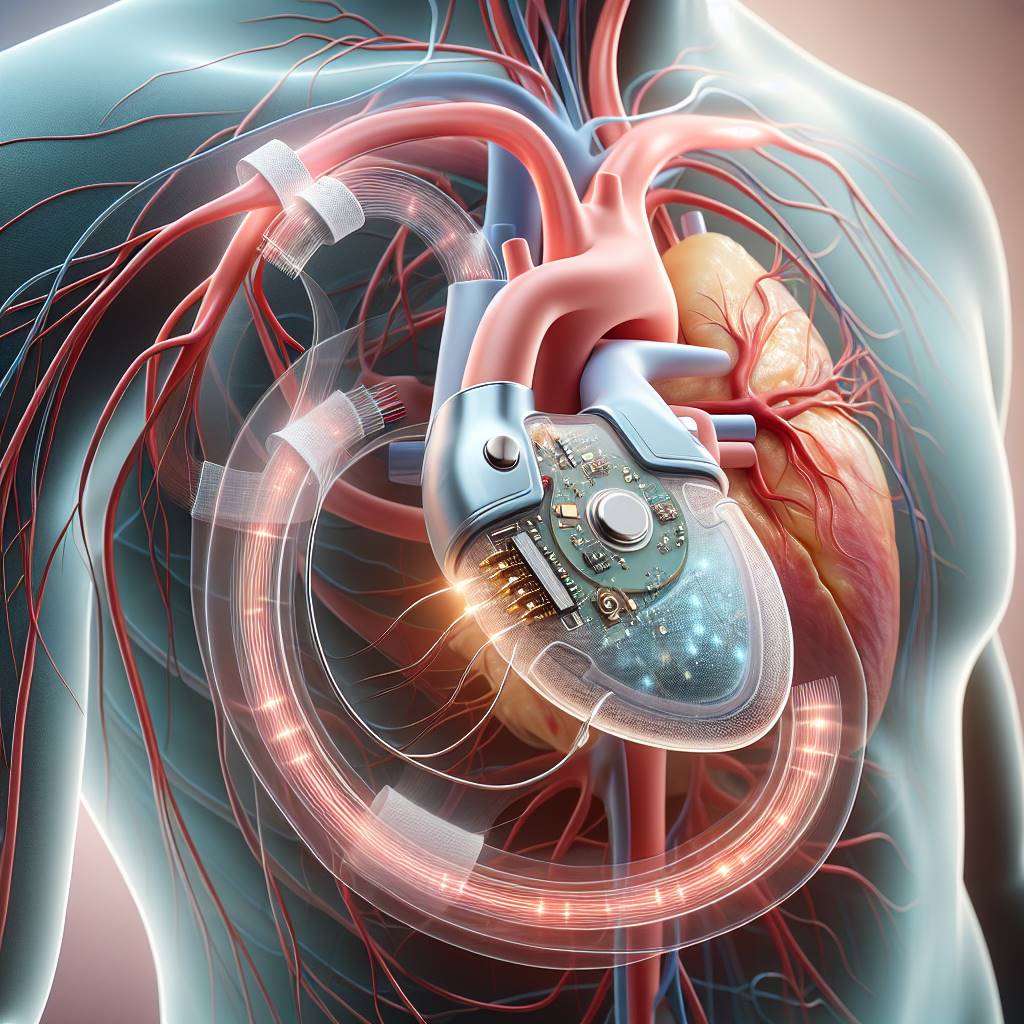A pacemaker is a small medical device implanted to regulate abnormal heart rhythms, ensuring the heart beats efficiently. Doctors use advanced pacemaker settings to tailor the device to each patient’s unique needs. This customization is crucial for managing conditions like arrhythmias and improving overall heart health.
Understanding how doctors adjust pacemaker programming can help patients feel more confident about their treatment. These settings are fine-tuned to address specific heart conditions, ensuring optimal performance. By learning about the process, patients can better communicate with their healthcare providers and actively participate in their care.
Understanding Pacemaker Settings: A Guide for Patients
Pacemaker settings are the parameters that control how the device functions to regulate your heart rhythm. These settings are adjusted based on your specific heart condition, such as bradycardia (slow heart rate) or atrial fibrillation. Doctors use advanced technology to program the pacemaker, ensuring it delivers electrical impulses at the right time.
Patients should know that pacemakers are not one-size-fits-all devices. The settings can be customized to suit individual needs, including heart rate limits, response to physical activity, and pacing modes. This personalization helps improve quality of life and reduces symptoms like fatigue or dizziness caused by irregular heartbeats.
Understanding these settings empowers patients to ask informed questions during follow-up visits. Regular check-ups ensure the pacemaker continues to function optimally, adapting to any changes in your heart's condition.

How Pacemakers Help Regulate Your Heart Rhythm
A pacemaker works by sending electrical signals to your heart to maintain a steady rhythm. It is especially beneficial for patients with arrhythmias, where the heart beats too fast, too slow, or irregularly. The device continuously monitors your heart's activity and activates when it detects an abnormal rhythm.
Pacemakers are equipped with sensors that adapt to your body’s needs. For example, during exercise, the device can increase your heart rate to meet the demand for more oxygen. This feature, known as rate responsiveness, is a key aspect of modern pacemakers.
By regulating your heart rhythm, pacemakers help alleviate symptoms like shortness of breath, fatigue, and fainting. They also reduce the risk of complications associated with untreated arrhythmias, such as stroke or heart failure. This makes them a vital tool in managing heart health.
Customizing Pacemaker Settings for Individual Heart Needs
Customizing pacemaker settings is a critical step in ensuring the device meets your specific heart requirements. Doctors consider factors like your age, activity level, and the type of heart condition being treated. For instance, a patient with bradycardia may need a higher minimum heart rate setting compared to someone with a different condition.
Pacemakers offer various pacing modes, such as single-chamber, dual-chamber, or biventricular pacing. Each mode is selected based on the heart's electrical system and the areas that need support. Doctors may also adjust the sensitivity of the device to detect and respond to changes in your heart rhythm.
Below is a table summarizing common pacemaker settings and their purposes:
| Setting |
Purpose |
| Minimum Heart Rate |
Ensures the heart does not beat too slowly. |
| Maximum Heart Rate |
Prevents the heart from beating too fast. |
| Rate Responsiveness |
Adjusts heart rate based on physical activity. |
What to Expect During Pacemaker Programming Sessions
Pacemaker programming sessions are routine appointments where doctors adjust the device’s settings to ensure optimal performance. During these sessions, a special device called a programmer communicates with your pacemaker wirelessly. This allows the doctor to review its activity and make necessary adjustments.
Patients may be asked about their symptoms, such as fatigue or dizziness, to determine if the current settings are effective. The doctor may also perform tests to evaluate how the pacemaker responds to different heart rhythms. These sessions are painless and typically last 30–60 minutes.
Regular programming sessions are essential for maintaining the pacemaker’s functionality. They help address changes in your heart condition and ensure the device continues to meet your needs. If you experience unusual symptoms, inform your doctor immediately, as this may indicate the need for reprogramming.
Key Factors Doctors Consider When Adjusting Pacemakers
Adjusting pacemaker settings involves careful consideration of several factors to ensure the device functions effectively. One key factor is the patient’s underlying heart condition, such as heart block or atrial fibrillation. The settings are tailored to address these specific issues.
Doctors also consider the patient’s lifestyle and activity level. For example, an active individual may require a higher rate responsiveness setting to accommodate physical exertion. Age and overall health are additional factors that influence the adjustments.
Below are some key considerations during pacemaker adjustments:
- Heart rate limits to prevent bradycardia or tachycardia.
- Sensitivity settings to detect abnormal rhythms accurately.
- Pacing mode selection based on the heart’s electrical system.
By taking these factors into account, doctors ensure the pacemaker provides reliable support, improving both heart function and quality of life.
How Pacemaker Modes Impact Your Heart's Function
Pacemakers are life-saving devices that help regulate your heart's rhythm. The device operates in different modes, each designed to address specific heart conditions. For instance, the DDD mode is commonly used for patients with atrial fibrillation, as it synchronizes the upper and lower chambers of the heart. Another mode, VVI, is ideal for those with slower heart rates or bradycardia.
Each mode is tailored to ensure your heart beats effectively, improving blood flow and oxygen delivery. Doctors select the mode based on your condition, symptoms, and activity level. Understanding these modes can help you feel more confident about your treatment.

Optimizing Pacemaker Settings for Active Lifestyles
For individuals with active lifestyles, pacemaker settings need to be carefully optimized. Modern pacemakers come with features like rate-responsive pacing, which adjusts your heart rate based on physical activity. This ensures that your heart can keep up with your body's demands during exercise or other strenuous activities.
Doctors may also adjust the upper rate limit to accommodate higher activity levels. This is particularly important for athletes or those who engage in regular physical activity. Additionally, settings like sensor sensitivity can be fine-tuned to detect changes in your body’s movements or breathing patterns.
By customizing these settings, your pacemaker can support a more active and fulfilling lifestyle, allowing you to engage in activities without worrying about your heart's rhythm.
Common Pacemaker Adjustments and What They Mean
Pacemakers are highly customizable, and doctors often make adjustments to ensure optimal performance. Some common adjustments include:
- Rate adjustments: Changing the heart rate to match your activity level or medical condition.
- Mode changes: Switching between modes like DDD or VVI based on your heart's needs.
- Voltage settings: Modifying the electrical impulses to ensure effective pacing.
These adjustments are typically made during follow-up visits, where doctors use specialized equipment to communicate with your pacemaker. Understanding these changes can help you stay informed and involved in your care.
How Doctors Monitor and Fine-Tune Pacemaker Settings
Doctors use advanced tools to monitor and adjust your pacemaker settings. During a follow-up appointment, they may perform a pacemaker interrogation, which involves connecting the device to a programmer. This allows them to review data, such as your heart's activity and the pacemaker's performance.
Based on this data, they can fine-tune settings like pacing thresholds or sensor sensitivity. Remote monitoring is another option, where your pacemaker sends data to your doctor via a secure network. This ensures continuous oversight without frequent hospital visits.
Regular monitoring and adjustments are crucial for maintaining your pacemaker's effectiveness and ensuring your heart remains healthy.
Pacemaker Sensitivity Settings: What You Should Know
Sensitivity settings in a pacemaker determine how well the device detects your heart's natural electrical signals. If the sensitivity is too low, the pacemaker might miss signals, leading to under-sensing. On the other hand, high sensitivity can cause over-sensing, where the device misinterprets external signals as heart activity.
Doctors carefully adjust these settings to strike the right balance. This ensures that the pacemaker only activates when necessary, preventing unnecessary pacing. Sensitivity settings are especially important for patients with irregular heart rhythms, such as arrhythmias.
By understanding how these settings work, you can better appreciate the precision involved in your pacemaker's operation and the role it plays in maintaining your heart's health.
Understanding Rate Response in Modern Pacemakers
Modern pacemakers are equipped with a feature called rate response, which adjusts the heart rate based on the patient’s activity level. This is particularly beneficial for individuals with bradycardia, where the heart beats too slowly to meet the body’s demands.
The pacemaker uses sensors to detect changes in the body, such as movement or breathing rate, and adjusts the pacing accordingly. This ensures that the heart delivers an adequate blood supply during exercise or rest. Without this feature, patients might experience fatigue or dizziness during physical activity.
Doctors carefully program the rate response settings to match the patient’s lifestyle and medical needs. This customization improves quality of life and ensures optimal heart function.

How Pacemaker Voltage Settings Affect Heart Performance
The voltage settings in a pacemaker determine how much electrical energy is delivered to the heart. These settings are crucial for ensuring that the heart contracts effectively without causing unnecessary strain or energy consumption.
Doctors adjust the voltage to the lowest level that still achieves consistent heartbeats. This reduces the risk of complications like lead dislodgement or battery depletion. High voltage settings may be required for patients with scar tissue around the leads, as this can impede electrical conduction.
By fine-tuning the voltage, healthcare providers ensure that the pacemaker operates efficiently while maintaining the patient’s cardiac health. Regular follow-ups are essential to monitor and adjust these settings as needed.
When and Why Pacemaker Settings Need Reprogramming
Pacemaker settings may need reprogramming for various reasons, including changes in the patient’s health or lifestyle. For instance, if a patient develops atrial fibrillation, the pacemaker may require adjustments to manage irregular heart rhythms effectively.
Other reasons for reprogramming include changes in medication, increased physical activity, or the detection of device-related issues. Regular check-ups allow doctors to assess the pacemaker’s performance and make necessary changes to optimize its function.
Reprogramming is a non-invasive process performed using a specialized device. It ensures that the pacemaker continues to meet the patient’s evolving needs, providing both safety and improved quality of life.
- Changes in health conditions
- Device performance issues
- Adjustments for lifestyle changes
Advanced Pacemaker Features for Better Heart Health
Today’s pacemakers come with advanced features that go beyond basic heart rate regulation. These include dual-chamber pacing, which coordinates the upper and lower chambers of the heart, and remote monitoring, allowing doctors to track the device’s performance remotely.
Some pacemakers also have algorithms to detect and respond to arrhythmias, providing immediate intervention. Features like adaptive pacing adjust the heart rate based on the patient’s activity levels, ensuring optimal performance during exercise or rest.
These innovations not only improve heart health but also enhance patient convenience and safety. By leveraging these advanced features, doctors can provide personalized care that aligns with the patient’s unique medical needs.
FAQs About Pacemaker Settings and Their Adjustments
Patients often have questions about their pacemaker settings. Here are some common queries:
- How often are settings adjusted? Settings are typically reviewed during routine check-ups, but adjustments may be needed if symptoms arise.
- Can I feel the pacemaker working? Most patients do not feel the device, but some may notice slight sensations during adjustments.
- What happens if settings are incorrect? Incorrect settings can lead to symptoms like fatigue or dizziness, which should be reported to a doctor immediately.
Understanding these aspects helps patients feel more confident about their pacemaker therapy and ensures they seek timely medical advice when needed.
Best Pacemaker Surgery Doctors in India
Two highly reputed doctors specializing in Pacemaker Settings in India are Dr. Balbir Singh, Chairman of Cardiology at Medanta - The Medicity, Gurugram, with over 30 years of experience in electrophysiology and cardiac pacing, and Dr. Praveen Chandra, Chairman of Interventional Cardiology at Medanta - The Medicity, Gurugram, with extensive expertise in advanced cardiac procedures and international recognition.
Learn more on best pacemaker implantation surgery doctors in india
Best Pacemaker Surgery Hospitals in India
Leading hospitals offering advanced Pacemaker Settings in India include Fortis Escorts Heart Institute, New Delhi, known for its NABH accreditation and cutting-edge cardiac care, and Apollo Hospitals, Chennai, a JCI-accredited facility with expertise in robotic-assisted cardiac procedures and international patient services. Both hospitals are renowned for their multidisciplinary teams and high success rates.
Find more best pacemaker implantation surgery hospitals in india
Pacemaker Surgery Cost in India
The cost of Pacemaker Settings in India typically ranges from INR 2,50,000 to INR 5,00,000 (approximately USD 3,000 to USD 6,000). Factors influencing costs include the type of pacemaker, hospital category, and doctor’s expertise. The average hospital stay is 2–5 days. India offers a significant cost advantage compared to Western countries, with options for medical insurance and third-party financing.
Learn pacemaker implantation surgery cost in india
Pacemaker Surgery Treatment in India
Pacemaker Settings in India involve implantation through a minimally invasive procedure, followed by programming to suit the patient’s heart rhythm. Advanced technologies like 3D mapping and remote monitoring are used. Recovery typically takes 1–2 weeks. Top hospitals in India adopt global medical protocols and innovations like leadless pacemakers to ensure optimal outcomes.
Learn on Pacemaker Surgery Treatment in India
FAQs
What is a pacemaker, and how does it work?
A pacemaker is a small medical device implanted in the chest to regulate abnormal heart rhythms. It sends electrical impulses to the heart to maintain a normal rhythm and prevent conditions like bradycardia.
How are pacemaker settings customized?
Doctors customize pacemaker settings based on the patient’s heart condition, activity level, and medical history. Adjustments include pacing rate, sensitivity, and response to physical activity.
How often should pacemaker settings be checked?
Pacemaker settings should be checked every 6–12 months or as advised by your doctor. Regular follow-ups ensure the device functions optimally and adapts to any changes in your heart condition.
Can pacemaker settings be adjusted remotely?
Yes, many modern pacemakers support remote monitoring, allowing doctors to adjust settings or monitor performance without requiring an in-person visit.
What are the risks of incorrect pacemaker settings?
Incorrect pacemaker settings can lead to symptoms like fatigue, dizziness, or irregular heartbeats. Regular follow-ups help prevent such complications.
How long does a pacemaker battery last?
The battery of a pacemaker typically lasts 5–15 years, depending on usage and device type. Your doctor will monitor battery life during routine check-ups.
Can I undergo MRI scans with a pacemaker?
Many modern pacemakers are MRI-compatible. However, it is essential to inform your doctor and the radiology team before undergoing an MRI scan.
What precautions should I take after pacemaker implantation?
Avoid heavy lifting, strenuous activities, and direct pressure on the implantation site for a few weeks. Follow your doctor’s advice for a safe recovery.
Are pacemakers safe for international travel?
Yes, pacemakers are safe for travel. Carry your pacemaker ID card and inform airport security about the device to avoid issues during screening.
What should I do if I feel unwell with a pacemaker?
If you experience symptoms like dizziness, chest pain, or irregular heartbeats, contact your doctor immediately. These could indicate a need for pacemaker adjustment.
Understanding Pacemakers: The Technology and Its Emotional Effects
Pacemakers are life-saving devices that help regulate heart rhythms, but their impact goes beyond the physical. Patients often experience a range of emotions after receiving a pacemaker, which can significantly affect their mental well-being. To explore this aspect further, check out our blog on the psychological impact of pacemaker implants, where we discuss the feelings and adjustments patients commonly face.
Understanding how a pacemaker functions can also alleviate some of these concerns. For a straightforward explanation of the device's mechanics, visit our article on how a pacemaker works. This resource breaks down the technology in an accessible way, helping patients feel more informed and empowered about their health.
By addressing both the emotional and technical aspects of pacemakers, we aim to support patients in their journey toward better heart health.